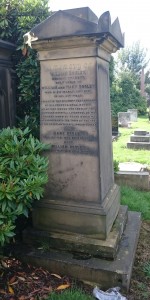Liverpool World Museum’s Egyptian collection is now in storage until the Autumn of 2016 while renovation work is carried out to the display area. Many of the exhibits were donated by local goldsmith Joseph Mayer in 1867 meaning the museum had the largest collection of Egyptology in Britain outside London. However earlier that decade there was an Egyptian influx into the port that was very unwelcome, when a ship from Alexandria brought fever to the town.
On 22nd February 1861 the Egyptian steam frigate Scheah Gehald arrived in at Sandon Dock in Liverpool carrying a crew of three hundred men, who had been accommodated in overcrowded conditions. Inadequately clothed for a North European winter, around a third were suffering from dysentery, exposure, frostbite and other effects of cold. Their situation was not helped by the ship doctor being incapacitated by illness and within a week of arrival six of the men had died, while 32 more were transferred to the Southern Hospital.
Three of those admitted to hospital died of dysentery but 24 were fit to be discharged within a week or two, of which one had his leg amputated. However six of the hospital staff, including three surgeons, contracted a fever. This resulted in the death of one surgeon and a nurse while several patients also became infected although survived. The surgeon who died, Dr Dooley, was just 20 years old and had been sent there from the Royal infirmary to replace another who had contracted the fever but survived. He had been an only child and died at the home of his parents in Ranelagh Street and was buried in Toxteth Park Cemetery. Another victim though was a churchman, Reverend Balls from St Mary’s Church in Grassendale, who had been visiting patients infected.

Dr Dooley’s grave in Toxteth Park Cemetery
A physician from the Southern Hospital named Dr Cameron described how on admission the 32 sailors were ‘swarming with vermin and in an indescribable state of filth.’ The board of the hospital instructed that all patients not infected be transferred elsewhere and those who were suffering were sent to the fever hospital. Only those in grave danger remained and at the beginning of April the building was closed for a month so that it could be whitewashed, cleaned and painted.
In the north end of town, an outbreak struck many who had cause to attend the public baths at Paul Street. Around two hundred sailors bathed there between 26th February and 1st March and had not shown any signs of disease. Then on 2nd March one of the male attendants was struck down with a fever and died, while a female was dangerously ill but recovered. The pilot who had brought the boat into Sandon Dock died of bronchitis and fever on the same day that the seamen who remained alive departed for Alexandria on another vessel. During the time in Liverpool, nine Egyptians had died of dysentery, but none contracted a fever. Investigations established that all those struck down with the fever had come into direct contact with the crew, but none of them had then passed on the disease to anybody else.
Rumours spread around the town that a type of plague was endemic, but Dr Cameron sought to give assurances that those being struck down were suffering from typhus fever. As bad as this was, it was not uncommon in large towns and despite the panic, deaths from the disease that March were still less than the same month the previous year. The Medical Officer of Health Dr William Henry Duncan reported to the Corporation that there was little chance of an epidemic, but it would be prudent in future that any ship that docks with a large number of crew who are sick should immediately be reported to the relevant authorities. When officers at the customs house were asked why the ship wasn’t quarantined, they replied that the pilot did not notice anything suspicious in that no sailors showed any outward signs of fever. The Mayor Samuel Robert Graves thanked Dr Duncan for his report and reassurances that the disease was disappearing, but stated that he would be bringing the matter up with the Dock Board, instructing them to make sure all pilots paid greater attention to the health of the crew when they boarded ships.
Although calm was soon restored to the town of Liverpool, the situation had only gotten worse for the crew of the frigate. When they arrived in Alexandria on 10th April, communication was sent saying that 32 of them had died on the return voyage. The ship’s British Captain had also died at Malta. He was one of eleven Europeans out of thirteen who had perished and the high mortality rate was put down to ‘gaol fever’ as a result of the lack of sanitation, cleanliness and ventilation.


So interesting Steven, I have been doing my ancestry for a few years and have often wondered why perhaps my grandfathers ancesters moved to the Midlands about 1860 Have thought work related but maybe your history on that time could have forced them They lived in the Woolton Wavertree area I really should try and visit and clarify I know they were Blacksmiths so should imagine at that time there was plenty of work
Regards and thank You Barbara
Glad it was off use to you Barbara